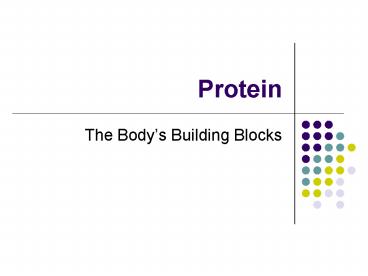Protein - PowerPoint PPT Presentation
Title:
Protein
Description:
Risks of too little protein Negative nitrogen balance Protein-energy malnutrition Kwashiorkor child does not reach full growth potential, common in poor ... – PowerPoint PPT presentation
Number of Views:83
Avg rating:3.0/5.0
Title: Protein
1
Protein
- The Bodys Building Blocks
2
What is Protein?
- Protein is an energy supplying nutrient made up
of carbon, hydrogen, oxygen and nitrogen. The
nitrogen is what makes it different from
carbohydrates and fats. - Proteins are formed from the combining of 20
different amino acids into different combinations
and patterns. - There are at least 30,000 different types of
proteins with a specific job or function, DNA is
one of them.
3
Functions of Protein
- Build and maintain tissues protein is needed to
form the structure of muscles, organs, skin,
blood, hair, nails, and every other body part. - Make important compounds these compounds
include enzymes, which cause specific chemical
reactions in the body. (example digestive
enzymes)
4
Function of Protein (cont.)
- Regulate mineral and fluid balance help carry
sodium and potassium from one side of cell walls
to the other. - Maintain acid-base balance maintains the
correct level of acidity of body fluid. - Carry vital substance helps transport fats,
iron and other nutrients, and oxygen through the
body.
5
Function of Protein (cont.)
- Provide Energy If carbohydrates and fats are
lacking in the diet, the body will use proteins
as an energy source.
6
Food Sources of Protein
- Animal Sources Animal flesh is the largest
source of protein in a meat-eating culture.
Although meat is an excellent source of protein,
some meat products are high in fat. - Source of Complete Proteins
- Plant Sources Protein is found in grains, nuts,
seeds, and legumes (peanuts, kidney beans,
lentils, chickpease, etc.) - Source of Incomplete Proteins
7
Types of Vegetarianism
- Vegans no food from any animal sources
- Lacto-vegetarians eat dairy products, but no
meat products or eggs - Lacto-ovo vegetarians dairy products and eggs,
but no meat products - Semivegetarians eat dairy, eggs, poultry, and
seafood, but no red meat
8
Reasons for Vegetarianism
- Religious reason
- Health reasons
- Socioeconomic reasons
- Environmental reasons
- Humanitarian reasons
- Vegetarians must be sure to choose
Complementary proteins.
9
The RDA for Protein
- 14 18 year-old males 52 grams
- 14-18 year-old females 46 grams
- 10-35 of your calories should come from protein.
Example a young woman who needs 2,400 calories a
day should eat a minimum of 240 calories from
protein. - Follow the food guide to ensure you get enough
the RDA of protein.
10
Risks of too little protein
- Negative nitrogen balance
- Protein-energy malnutrition
- Kwashiorkor child does not reach full growth
potential, common in poor cultures - Marasmus muscles and tissues begin to waste
away, child becomes thin, weak, and susceptible
to infection and disease
11
Excess proteins in diet
- Liver and kidney problems
- Calcium Loss
- Excess body fat

